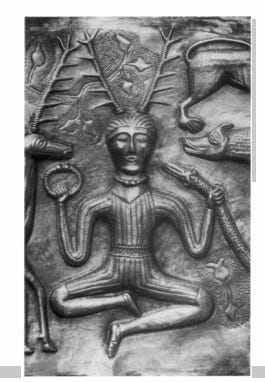The Celtic Shaman from the Gunderstrup Cauldron
The Celtic world once stretched from the far East of Europe to the edge of the Atlantic; now it is limited to Wales, Scotland, Ireland, and to Brittany and parts of Galicia. The fascination with future events which existed among the people who lived in these areas from around the 3rd century BC, finds expression in many ways. Practitioners of the various arts of divination are recorded from the earliest times and are still recognised as part of a continuing tradition - though now it is those who possess 'the second sight' who predict the future, and the old methods of divining are virtually forgotten. However, references to a number of methods survive, and we can get a clear picture of how these worked and how they were practised by looking into the rich heritage of the Celtic tradition.
Among the systems and methods of which we find mention are divination by the throwing of Ogam Sticks; Nealdoracht or Cloud Reading; several kinds of Incubatory Sleep, in which the precognitive dreams of individuals were studied and interpreted; and three mysterious methods of divining events known by the enigmatic titles of Imbas Forosnai (Enlightened Manifestation), Tenm Laida (Illumination by Song), and Dichetal do Chennaib (Meditation on the Finger Ends). In addition are several methods of Augury practiced in particular among the Gaels of Scotland. If we look at each of these in more detail we find that there is a surprising commonalty to each and every one.
Ogam (Ogham)
The principle method of divination of which we know is the use of Ogam (Ogham), a form of archaic alphabet the uses of which were many and varied. It has been called 'the Secret Language of the Poets' and formed an important part of the Bardic teachings in both Wales and Ireland. Hundreds of standing stones have been discovered, bearing inscriptions in Ogam, some of which refer to famous heroes, while others are believed to have been boundary markers.
An Ogham Stone from Ireland
But the uses of Ogam go far beyond this, being capable of sophisticated application and great subtlety of allusion. In the hands of a master it could be made to convey a wide range of meanings, and was almost certainly used to convey secret messages in a type of code.
The Ogam alphabet consists of 2O letters, arranged in groups of five, which are constructed from series of straight lines incised across a single stave (5 more letters, of a more complex structure, are thought to have been added some time after the original number. The whole alphabet looks like this:
The Ogham Alphabet






